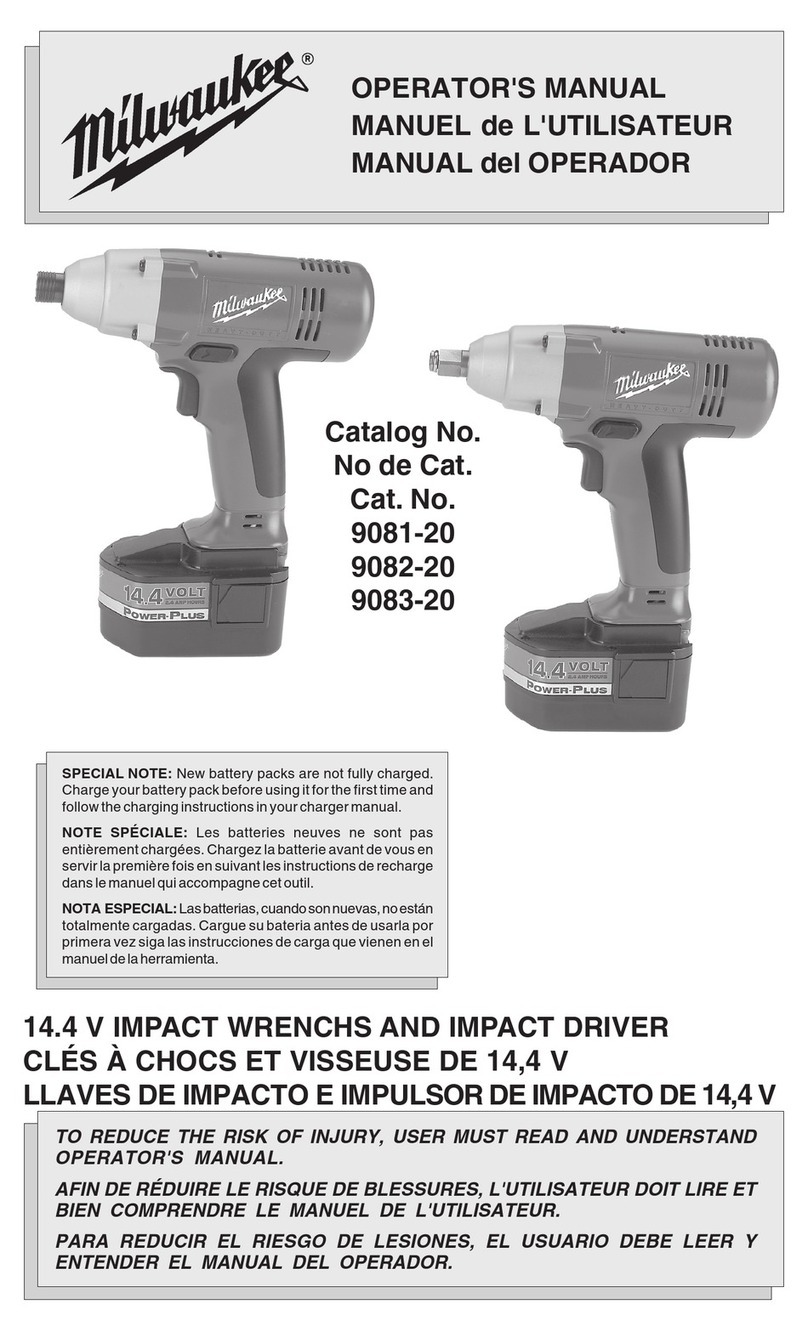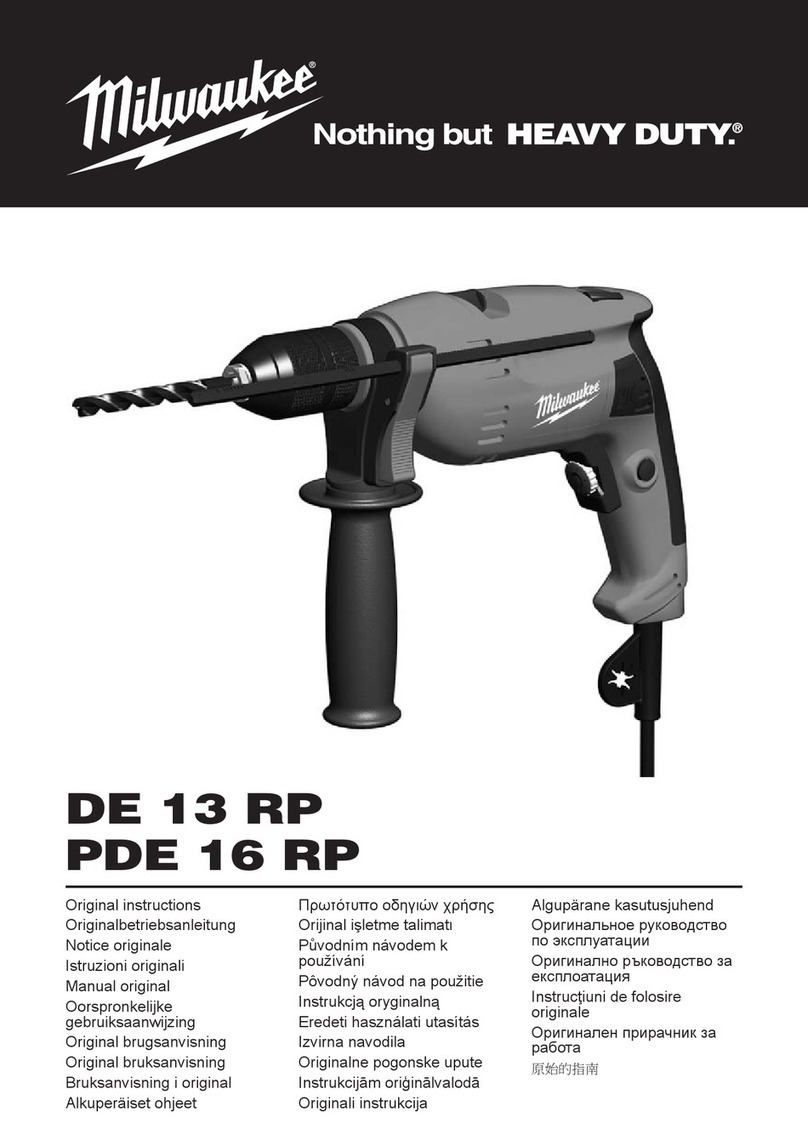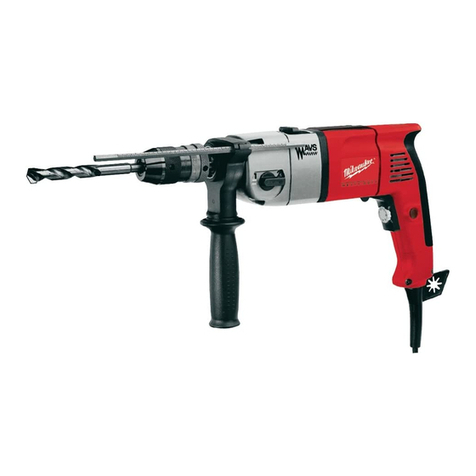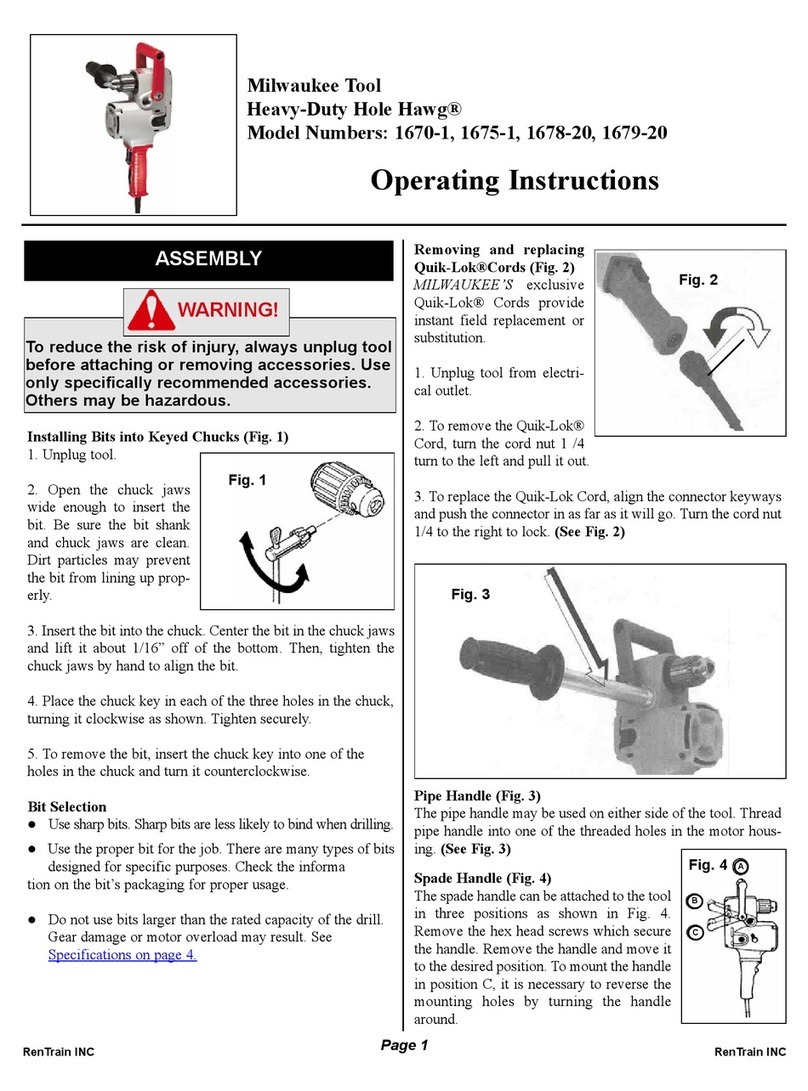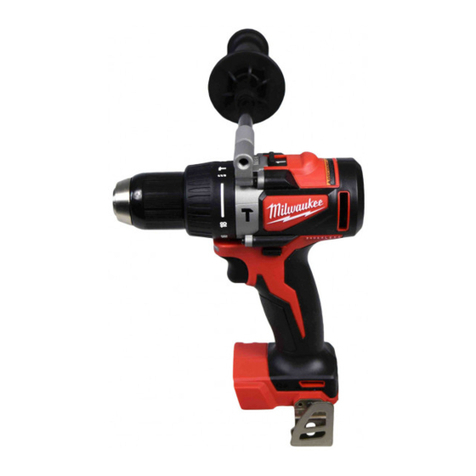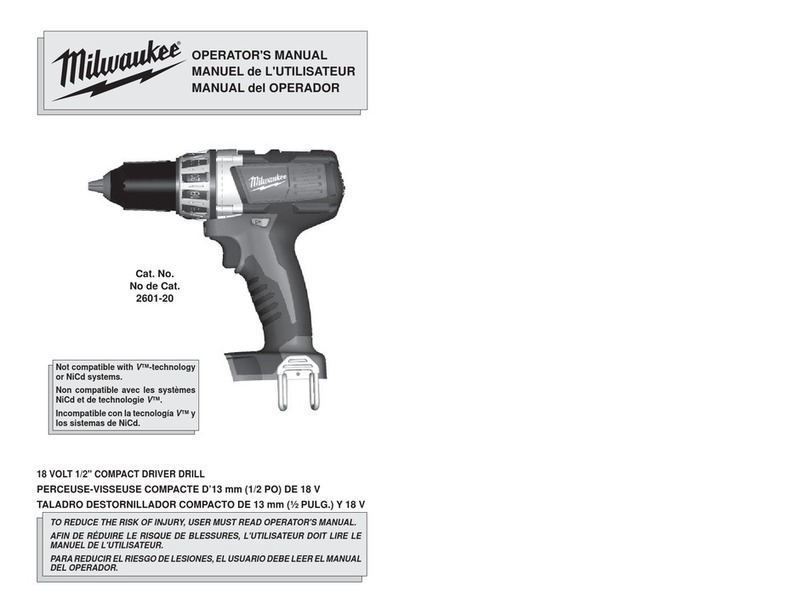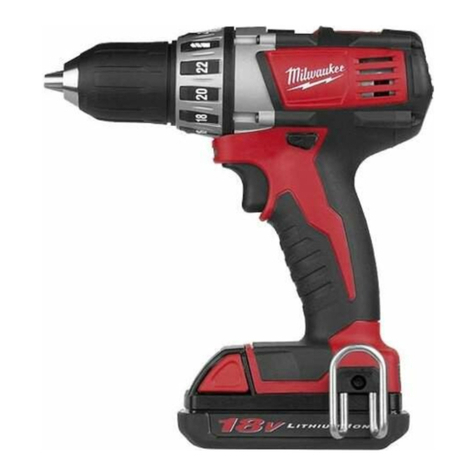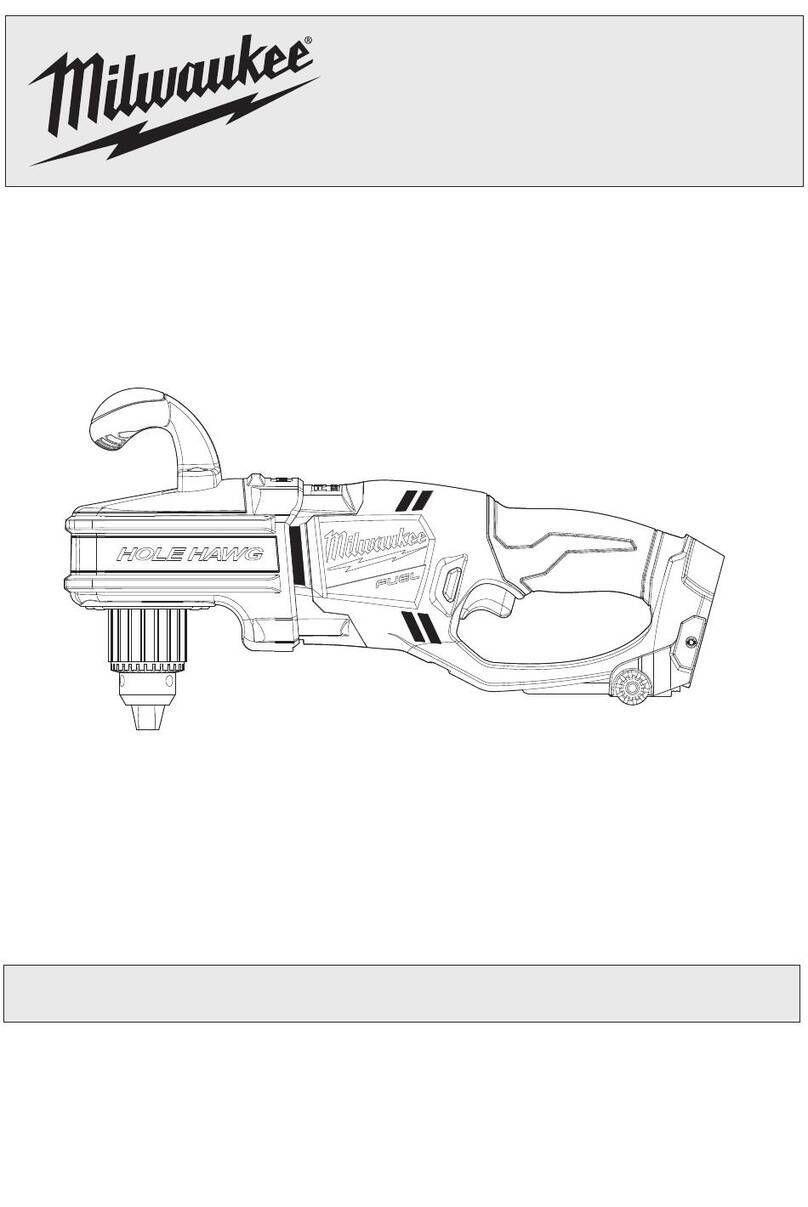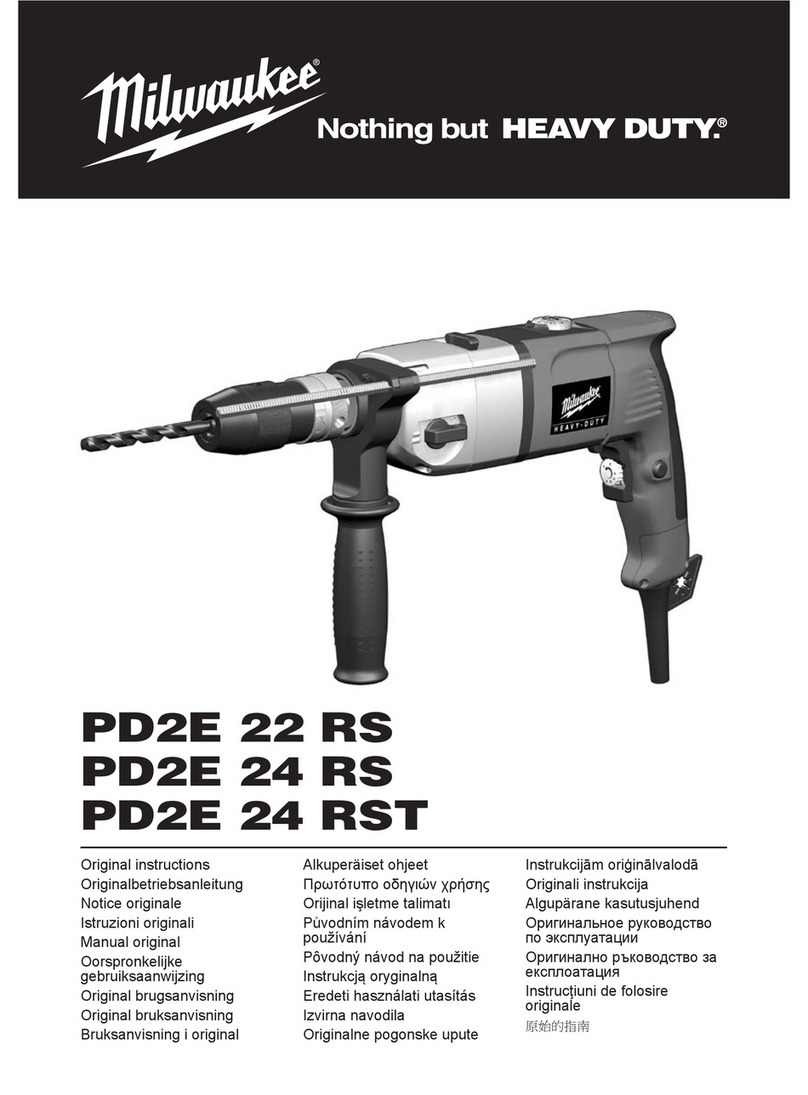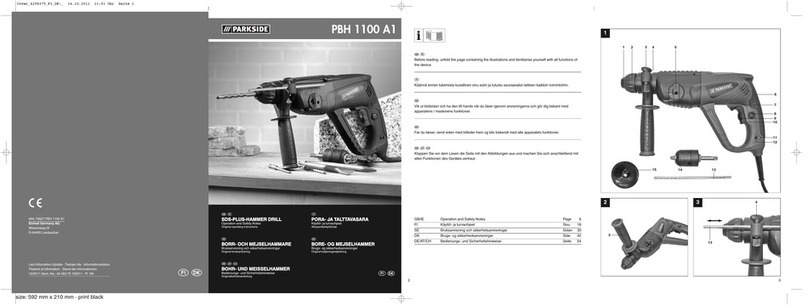67
If the bit binds, the drill will suddenly react in the
opposite direction of the rotation of the bit. Figure
4 shows the path of reaction, (1) if the drill bit binds
while being driven in forward (2).The operator
shouldreduce the chancesof a suddenreaction by
following the instructions listed below. The opera-
tor should also prepare for a sudden reaction by
holding securely using the pipe handle or bracing
against a solid fixed object.
To reduce the chance of bit binding:
•Use sharp bits. Sharp bits are less likely to bind
when drilling.
•Use the proper bit for the job. There are many
types of bits designed for specific purposes.
•Avoid drilling warped, wet, knotty, and or pitchy
material if possible.
•Avoiddrilling in materialthat you suspectcontains
hidden nails or other things that may cause the bit
to bind.
The direction of reaction is always opposite of the
directionof bitbinding. Reactionis evenmore likely
tooccur whenenlarging already existingholes and
at the point when the bit breaks through the other
side of the material.
Bracing for forward rotation
Reversing
A reversing switch is located below or above the
triggerswitch for removal of bits from holes.Permit
themotor tocome toa completestop beforerevers-
ing.Reversing thetool withthe gears inmotion may
cause severe damage. When removing selfeed
bits from partially drilled holes, a flick of the trigger
switch will free the threaded pilot screw. When the
threads are loose, lift the bit from the workpiece
with the motor stopped.
Bit Selection
•Use sharp bits. Sharp bits are less likely to bind
when drilling.
•Use the proper bit for the job. There are many
typesof bitsdesigned forspecific purposes.Check
the information on the bit's packaging for proper
usage.
•Donot use bitslarger thanthe ratedcapacity ofthe
drill. Gear damage or motor overload may result.
See Specifications.
Drilling
Before drilling, clamp the material down securely.
A poorly secured piece of material may result in
personal injury or inaccurate drilling. When drilling
in light gauge metal or wood, use a wooden block
to back up the material to prevent damage to the
workpiece.
When drilling in forward, the bit will rotate in a
clockwise direction. If the bit binds in the hole, the
bitwill come toa sudden stopand drillwill suddenly
react in a counterclockwise direction.
Figure 5 shows an example of a Compact Hole-
Shooter properly braced for forward rotation.
1. Forward (clockwise) rotation
2. Reaction
3. Brace drill with pipe handle here
Ifthe bitbinds, the pipehandle orthe motorhousing
bracedagainst the studwill hold thedrill inposition.
Bracing for reverse rotation
When drilling in reverse, the bit will rotate in a
counterclockwise direction. If the bit binds in the
hole, the bit will come to a sudden stop and the
drill will suddenly react in a clockwise direction.
Figure 6 shows an example of a Compact Hole-
Shooter properly braced for reverse rotation.
Fig. 5
1
2
3
Fig. 6
1
2
3
1. Reverse (counterclockwise) rotation
2. Reaction
3. Brace drill with pipe handle here
Ifthe bitbinds, the pipehandle orthe motorhousing
bracedagainst the studwill hold thedrill inposition.
Fig. 7 Fig. 8
ACCESSORIES
For a complete listing of accessories refer to your
MILWAUKEE Electric Tool catalog or go on-line
to www.milwaukeetool.com. To obtain a catalog,
contact your local distributor or a service center.
WARNINGTo reduce the risk of injury,
always unplug the tool before attaching or
removing accessories. Use only specifically
recommended accessories. Others may be
hazardous.
Maintaining Tools
Keep your tool in good repair by adopting a regular
maintenance program. Before use, examine the
general condition of your tool. Inspect guards,
switches, tool cord set and extension cord for
damage. Check for loose screws, misalignment,
binding of moving parts, improper mounting, bro-
ken parts and any other condition that may affect
its safe operation. If abnormal noise or vibration
occurs, turn the tool off immediately and have the
problem corrected before further use. Do not use a
damaged tool. Tag damaged tools “DO NOT USE”
until repaired (see “Repairs”).
Undernormal conditions,relubrication isnot neces-
sary until the motor brushes need to be replaced.
After six months to one year, depending on use,
returnyour toolto the nearestMILWAUKEEservice
facility for the following:
•Lubrication
•Brush inspection and replacement
•Mechanical inspection and cleaning (gears, spin-
dles, bearings, housing, etc.)
•Electrical inspection (switch, cord, armature, etc.)
•Testing toassure proper mechanicaland electrical
operation
WARNINGTo reduce the risk of injury,
electric shock and damage to the tool, never
immerse your tool in liquid or allow a liquid
to flow inside the tool.
MAINTENANCE
WARNINGTo reduce the risk of injury,
always unplug your tool before performing
any maintenance. Never disassemble the tool
or try to do any rewiring on the tool’s electrical
system.Contact aMILWAUKEE service facility
for ALL repairs.
Cleaning
Clean dust and debris from vents. Keep the tool
handles clean, dry and free of oil or grease. Use
only mild soap and a damp cloth to clean your
tool since certain cleaning agents and solvents
are harmful to plastics and other insulated parts.
Someof theseinclude: gasoline,turpentine, lacquer
thinner,paint thinner, chlorinatedcleaning solvents,
ammonia and household detergents containing
ammonia. Never use flammable or combustible
solvents around tools.
Repairs
If your tool is damaged, return the entire tool to the
nearest service center.
Mark the center of the hole to be drilled with a
center punch to give the bit a start and to prevent
it from "walking." Lubricate the drill bit with cutting
oil when drilling iron or steel. Use a coolant when
drilling nonferrous metals such as copper, brass
or aluminum.
To start a selfeed bit, run the threaded feed screw
into the work by flicking the trigger switch, permit-
ting the bit to coast until the teeth contact the work
surface. Align the bit properly before proceeding.
Thiswill reducecocking andjamming whenstarting.
To reduce jammingon breakthrough, decrease the
drilling pressure when the feed screw point breaks
through the workpiece. Proceed with steady, even
pressure.
Speed Control Dial
Catalog number 1663-20 has a Speed Control
Dial to provide electronic speed control. (The
trigger does not control the speed - it only turns
the tool on and off). The dial is located on rear of
the handle. The dial has positions numbered 1-8.
Position 8 provides full speed at no load. Position
1 provides approximately 25% of the full no load
speed. Reduced speed can be useful for starting
bits and obtaining the optimum speed for a given
bit size. Do not adjust the speed while drilling. This
toolis furnishedwith ElectronicFeedback toprovide
a more constant speed under load.
